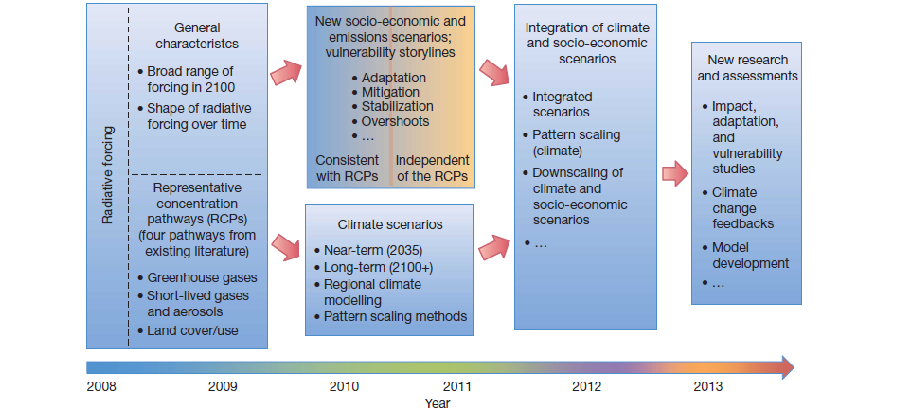The next generation of scenarios for climate change
Richard A. Moss et al. Nature – 463, doi:10.1038/nature08823.
The article describes how model-based scenarios are used in climate change research, and it explains the new multidisciplinary process for developing scenarios for the next assessment reports of the Intergovernmental Panel on Climate Change. The new process (see figure) will allow for closer collaboration between impacts, adaptation, vulnerability researchers, and climate modelers. This closer collaboration will lead to better uncertainty estimates for the future projections and shorten the time from the development of the future scenarios to their use in climate models. More attention will be paid to adaption strategies, mitigation options and potentially large feedbacks such as melting of permafrost or melting of large volumes of land ice. The climate research community is responding to society’s interest in the last IPCC report, and the clear demand for information that is better suited for policy and planning purposes.
The lead author is Richard H. Moss (Joint Global Change Research Institute); 17 other researchers who have been IPCC authors and contributors and who represent other major climate research and modeling centers around the world (GFDL, NCAR, DOE, UK Meteorological Office, etc.) are also coauthors on this paper.
Reference:

Figure 4: The parallel process. This figure depicts the process of developing new scenarios that will be used in future climate change research and impacts assessments. The process began with identification of radiative forcing characteristics that support modelling of a wide range of possible future climates. Representative concentration pathways (RCPs) were selected from the published literature to provide needed inputs of emissions, concentrations and land use/cover for climate models. In parallel with development of climate scenarios based on the RCPs, new socio-economic scenarios (some consistent with the radiative forcing characteristics used to identify the RCPs and some developed to explore completely different futures and issues) will be developed to explore important socio-economic uncertainties affecting both adaptation and mitigation. Using a variety of tools and methods, such as pattern scaling, the new socio-economic scenarios will be integrated with the new climate scenarios. New research using the integrated scenarios will explore adaptation, mitigation and other issues such as feedbacks, using consistent assumptions. This research will provide insights into the costs, benefits and risks of different climate futures, policies and socio-economic development pathways.
Reference
Moss, R H., et al., February 2010: The next generation of scenarios for climate change research and assessment. Nature, 463, doi:nature08823.
Click here to access the manuscript that is in press.


